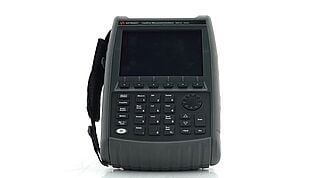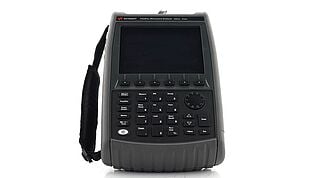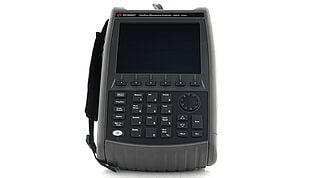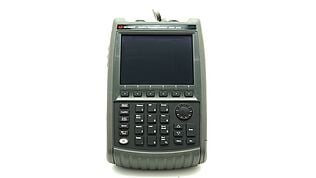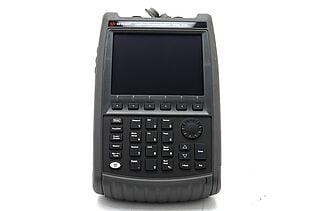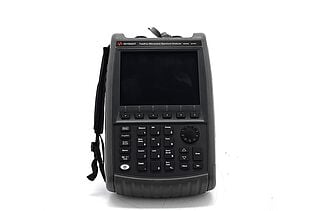- Introduction
- Why Handheld Oscilloscopes?
- Ultimate Portability and Compactness
- Flexibility in Diverse Situations
- Cost-Effective Solutions for Modern Needs
- Seamless Integration with Modern Tech
- Top 10 Tips
- Tip 1: Understand Your Specific Needs
- Tip 2: Focus on Quality and Brand Reputation
- Tip 3: Pay Attention to Bandwidth and Sampling Rate
- Tip 4: Evaluate Memory Depth
- Tip 5: Assess Probe Compatibility and Accessories
- Tip 6: Ensure Easy-to-Use Interface
- Tip 7: Inspect Battery Life for Field Applications
- Tip 8: Consider Ruggedness for Field Use
- Tip 9: Demand Connectivity and Data Transfer Options
- Tip 10: Prioritize Built-In Functions and Analysis Capabilities
- 4 Reasons You Might Want a Benchtop Oscilloscope
- The Allure of Refurbished Handheld Oscilloscopes
- Making the Right Investment: Think Long-Term
- Whenever You’re Ready, Here Are 5 Ways We Can Help You
Have you ever been troubleshooting a mission-critical system in a remote location, miles away from your well-equipped lab, when an elusive electrical issue brings everything to a standstill?
Imagine the frustration of knowing that the one device that could solve your problem—an oscilloscope—is sitting far away on your workbench.
In situations like these, a handheld oscilloscope transforms from a mere convenience into an essential lifeline, enabling on-the-spot diagnostics to get your project back on track.
Gone are the days when oscilloscopes occupied a large portion of your workbench. Modern models pack powerful features into small portable, handheld units. These compact devices offer engineers unprecedented flexibility and convenience, enabling real-time data analysis just about anywhere.
Ready to make your fieldwork more efficient and stress-free? Keep reading to discover the top 10 tips for choosing the perfect handheld oscilloscope for your engineering needs.
Why Handheld Oscilloscopes?
In a world where engineering challenges don't always present themselves in neat, lab-friendly environments, having the right tools at your fingertips matters more than ever.
This is where handheld oscilloscopes come into play. They offer an agile, flexible solution for engineers who need to make accurate, real-time measurements in a variety of settings.
Ultimate Portability and Compactness
The ability to effortlessly carry your portable oscilloscope from one site to another revolutionizes the way you approach fieldwork. These devices weigh just a fraction of their benchtop counterparts but deliver a powerful punch in terms of functionality.
Handheld oscilloscopes easily slide into your toolkit or backpack, making them perfect for engineers who find themselves hopping between multiple job sites, client locations, or even remote areas with limited accessibility.
This level of portability not only saves you the hassle of lugging around cumbersome equipment but also dramatically cuts down on the time you'd spend going back and forth to your lab for diagnostics.
In fast-paced industries where time is money, the convenience and efficiency provided by a handheld oscilloscope can be the difference between meeting deadlines and falling behind.
Flexibility in Diverse Situations
Imagine you're working on a wind turbine installation, troubleshooting automotive systems on the road, or diagnosing network issues in an underground data center. In all these scenarios, bringing in a traditional benchtop oscilloscope is either impractical or impossible.
Handheld oscilloscopes shine in such unconventional or remote locations where you need precise measurements but can't set up a full lab environment. The flexibility they offer enables you to tackle a wide range of problems on-the-spot, giving you the edge in solving issues quickly and efficiently.
Cost-Effective Solutions for Modern Needs
As technology advances, so does the affordability of high-quality tools. Handheld oscilloscopes are no exception. Once a high-cost item reserved for well-funded labs, these devices have become increasingly budget-friendly.
This makes them a valuable addition not just for industry veterans, but also for freelancers, educational institutions, and startups operating on tighter budgets.
Investing in a handheld oscilloscope now becomes a smarter, more cost-effective decision that pays off in the long run, providing robust functionality without breaking the bank.
Seamless Integration with Modern Tech
Modern handheld oscilloscopes don't just rest on their laurels of portability and affordability; they also offer seamless integration with today's rapidly evolving tech landscape.
Many models come with connectivity options like USB ports, Wi-Fi, and Bluetooth, allowing for easy data transfer to laptops or cloud storage. Some even feature touchscreen interfaces and compatibility with mobile apps, offering an intuitive user experience.
These features ensure that handheld oscilloscopes not only meet the current demands of engineers but also keep pace with emerging technologies and workflow preferences.
Find Handheld Oscilloscopes On Sale
Top 10 Tips
Ready to level up your engineering game with the perfect handheld oscilloscope? Choosing the right device can be a game-changer, but with so many options out there, the decision can seem overwhelming.
Here are our top 10 tips that will not just guide you to the right purchase, but also set you up for success in any engineering challenge that comes your way.
Tip 1: Understand Your Specific Needs
Before you even start browsing models, take a deep dive into the specific requirements of your work.
Are you mostly in the field or in a lab? What is the frequency range you commonly deal with? Do you need advanced math functions or just basic waveform analysis?
By understanding your specific needs, you can narrow down your choices and ensure that you invest in a handheld oscilloscope that’s up to the task.
Potential needs to consider include:
- Frequency range: Does your work involve low-frequency signals like audio circuits, or high-frequency signals such as RF communication?
- Resolution and accuracy: Do you need highly accurate measurements, or is a general overview sufficient?
- Input channels: How many signals will you need to measure simultaneously?
- Battery life: Is extended battery life crucial for long hours in the field?
- Connectivity: Do you require options like Wi-Fi or USB to upload data for further analysis?
Understanding these factors will help you tailor your purchase to your unique circumstances, ensuring maximum utility from your handheld oscilloscope.
Tip 2: Focus on Quality and Brand Reputation
When investing in a handheld oscilloscope, don't skimp on quality. Renowned brands like Keysight have built a reputation for delivering exceptional precision, durability, and advanced features. These devices often outperform and outlast cheaper models, making them more cost-effective in the long run.
But quality isn't just about the device's performance; it also extends to customer support. Keysight offers comprehensive warranties and responsive technical support.
When you encounter any challenges or questions while using your device, you know you've got a dependable team to turn to for solutions. This kind of support can be invaluable, especially when you're working on critical projects with tight deadlines.
Here are some aspects to consider when focusing on quality and brand:
- Durability: Will the device withstand the rigors of field use?
- Precision: Does the brand have a reputation for highly accurate measurements?
- Warranty: What kind of warranty does the brand offer, and what does it cover?
- Technical support: Is help readily available, either online or through customer service, to solve any issues that may arise?
Choosing a reputable brand like Keysight assures you not only of a top-performing device but also of a safety net of technical support and warranty protections. This dual assurance makes the investment worthwhile, letting you focus on what you do best—engineering solutions.
Tip 3: Pay Attention to Bandwidth and Sampling Rate
One of the most crucial aspects to consider when selecting a handheld oscilloscope is its bandwidth and sampling rate.
Bandwidth refers to the range of frequencies the oscilloscope can accurately measure. Sampling rate, on the other hand, indicates how many samples the device takes per second, which affects the accuracy of waveform representation.
For instance, if you're working on high-frequency applications like RF (Radio Frequency) circuits, a device with inadequate bandwidth will distort the signal. The consequences could range from minor inaccuracies to complete failure in identifying signal issues, compromising the integrity of your entire project.
| Application | Ideal Bandwidth |
| Audio Circuits | 20 kHz – 100 kHz |
| Embedded Systems | 50 MHz – 100 MHz |
| Automotive | 100 MHz – 200 MHz |
| RF Communications | 500 MHz – 1 GHz |
Here's how to determine the suitable specs for your tasks:
- Bandwidth: A good rule of thumb is to choose a bandwidth that's at least five times higher than the maximum frequency you'll be measuring.
- Sampling rate: Look for a sampling rate that's at least twice the oscilloscope's bandwidth for accurate waveform representation.
Let's consider an example: If you choose an oscilloscope with a 50 MHz bandwidth for an RF circuit operating at 200 MHz, the device will not only fail to capture the signal accurately, but it might also give you misleading information. In a worst-case scenario, this could lead you to make incorrect adjustments, causing system failures or reduced performance.
Understanding the implications of bandwidth and sampling rate ensures you'll pick a device that matches your application's needs, thereby safeguarding the reliability and accuracy of your work.
Tip 4: Evaluate Memory Depth
Don't overlook the importance of memory depth when selecting your handheld oscilloscope. Memory depth refers to how many data points the oscilloscope can store and display, directly affecting how much of a waveform you can view in detail at one time.
This becomes particularly crucial when you're working with complex or longer-duration signals, as inadequate memory depth can result in a truncated or distorted waveform display.
Having ample memory depth allows you to zoom in on specific sections of a waveform for a closer analysis while maintaining high resolution.
For example, if you're troubleshooting a digital communication issue where you need to look at both the big picture and individual packets, an oscilloscope with high memory depth will capture the full sequence without sacrificing granularity.
Consider these factors when evaluating memory depth:
- Signal complexity: More complex signals require higher memory depth for accurate representation.
- Duration of capture: If you need to capture a signal over an extended period, make sure the oscilloscope's memory depth can accommodate it.
- Resolution needs: Higher memory depth allows for finer resolution when zooming in on specific parts of the waveform.
By giving due consideration to the memory depth, you ensure that your handheld oscilloscope can capture the level of detail needed for your specific applications, thereby enhancing the reliability and accuracy of your measurements.
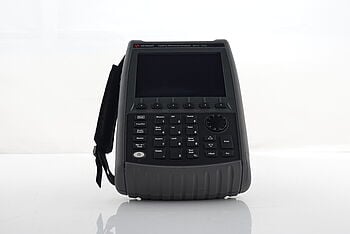
Tip 5: Assess Probe Compatibility and Accessories
The handheld oscilloscope itself is just one part of the equation; you also need to consider the probes and accessories that come with it or can be used alongside it.
Probes are essential for making accurate measurements, and their quality can directly affect your results. Moreover, not all probes are universally compatible, so ensure that the probes you intend to use are fully compatible with your chosen oscilloscope.
Popular Probe Types and Their Applications:
- Passive probes: Suitable for low-frequency signals, such as audio and power circuits.
- Active probes: Used for high-frequency or low-level signals, common in RF and digital circuit design.
- Current probes: Essential for measuring current waveforms in circuits.
- Differential probes: Useful for measuring signals that aren't referenced to ground, such as in power electronics.
- High-voltage probes: Designed for safely measuring high-voltage signals like those in power grids.
When choosing an oscilloscope, also look for:
- Extra probe ports: More ports give you the flexibility to measure multiple signals simultaneously.
- Included accessories: Check what's included in the package. Some oscilloscopes come with carrying cases, adapters, or other useful accessories.
- Availability of accessories: Make sure that additional probes and accessories are readily available for purchase, either from the manufacturer or third-party vendors.
By paying attention to probe compatibility and the availability of useful accessories, you enhance the versatility and performance of your handheld oscilloscope, making it a more effective tool for a wider range of applications.
Tip 6: Ensure Easy-to-Use Interface
In the heat of fieldwork, the last thing you want to wrestle with is a complicated interface. A handheld oscilloscope with an intuitive, easy-to-use interface can significantly streamline your tasks, allowing you to focus on problem-solving rather than navigating through menus and buttons.
An accessible interface becomes especially crucial in field scenarios where time is of the essence. A straightforward interface helps you quickly set up measurements, analyze waveforms, and make timely decisions.
Key aspects to consider for user-friendliness include:
- Display quality: A clear, high-resolution display enables easier data interpretation.
- Touchscreen vs. buttons: Some engineers prefer the tactile feel of buttons, while others find touchscreens more intuitive. Choose based on your preference.
- Menu layout: Look for an interface with logically organized menus and quick access to frequently-used functions.
- Customization: An oscilloscope that allows you to customize settings and save profiles can speed up repetitive tasks.
- Shortcut Features: Shortcuts for commonly-used functions can significantly reduce setup time.
By opting for a handheld oscilloscope with a user-friendly interface, you not only make your life easier but also become more efficient, making better use of your time in fast-paced or high-pressure environments.
Tip 7: Inspect Battery Life for Field Applications
If you're an engineer working in remote locations or places where constant power access isn't guaranteed, battery life should be at the top of your checklist.
A handheld oscilloscope with a robust, long-lasting battery can be a lifesaver in such situations, enabling you to carry out extended measurements without worrying about the device dying on you.
Consider this: You're in a remote area working on a vital project, and your oscilloscope's battery drains quicker than anticipated. You're now left with either incomplete data or a stalled project, both of which could lead to delays and increased costs.
To avoid such scenarios, look for:
- Battery life specifications: Manufacturers usually provide expected battery life based on standard usage. Make sure it aligns with your fieldwork demands.
- Replaceable batteries: The option to quickly swap out a drained battery for a charged one can extend your working time considerably.
- Power saving modes: Some oscilloscopes come with power-saving options that can extend battery life when full performance isn't required.
- Charging options: Check for multiple charging options like USB-C or car adapters, which can be handy in the field.
By prioritizing battery life, you equip yourself with a tool that's reliable for extended periods, thereby ensuring that you can focus on the engineering challenges at hand, rather than worrying about finding the nearest power outlet.
Tip 8: Consider Ruggedness for Field Use
For engineers who frequently work in challenging environments, the ruggedness of a handheld oscilloscope is non-negotiable. A device that can withstand the rigors of field use, including exposure to moisture, dust, and accidental drops, is not just a convenience—it's a necessity.
Think about it: You're on a construction site or perhaps doing maintenance work in an industrial plant. The last thing you need is for your oscilloscope to fail because it wasn't built to withstand a bit of dust or a minor fall. A rugged device ensures that you maintain consistent performance levels, irrespective of the challenges posed by your work environment.
Look for these features to gauge ruggedness:
- Waterproofing: A waterproof casing can protect the device from moisture and even light rain.
- Dustproofing: A dustproof design is essential when working in environments like construction sites or deserts where dust is prevalent.
- Drop resistance: Drop-resistant features can save your device—and your data—in case of accidental slips or falls.
- Environmental ratings: Check for any IP (Ingress Protection) ratings that confirm the device's ability to resist environmental elements.
By prioritizing a rugged design, you opt for a handheld oscilloscope that won't let you down, no matter where your engineering tasks take you. This kind of reliability can make all the difference when you're out in the field, grappling with time-sensitive issues.
Tip 9: Demand Connectivity and Data Transfer Options
In today's interconnected world, the ability to quickly and easily transfer data from your handheld oscilloscope to other devices is not just a nice-to-have—it's essential.
Modern oscilloscopes offer various connectivity options, such as USB, Wi-Fi, and Bluetooth, making it easier than ever to share your measurements and collaborate with colleagues or clients.
Imagine you're in the field and need to immediately share your findings with a remote team for analysis.
Wi-Fi or Bluetooth-enabled data transfer enables real-time collaboration, expediting problem-solving and decision-making processes.
USB connections also provide a reliable, high-speed data transfer option when wireless connectivity isn't necessary.
Keep an eye out for:
- Associated software: Many oscilloscopes come with PC software that allows for deeper data analysis, offering features that might not be available on the oscilloscope's built-in interface.
- Mobile app integration: Some oscilloscopes can connect to mobile apps, enabling remote viewing and control—a boon when you're on the move or need to multitask.
By demanding modern connectivity options, you ensure that your handheld oscilloscope serves as an integrated part of a broader analytical and problem-solving toolkit, allowing for more streamlined and efficient workflows.
Tip 10: Prioritize Built-In Functions and Analysis Capabilities
While basic functionality is a given, an oscilloscope that comes with built-in analysis tools can be a game-changer in terms of efficiency and ease-of-use.
Functions like built-in math operations and Fast Fourier Transform (FFT) analysis enable you to conduct complex signal processing directly on the device, saving you time and effort.
Imagine capturing a waveform and immediately performing a Fourier analysis to identify any frequency-domain issues, all without needing to transfer data to a separate software application.
This kind of built-in functionality streamlines your tasks, enabling quicker decisions and more effective troubleshooting.
Key built-in features to look for:
- Math functions: Addition, subtraction, multiplication, and division for on-the-fly calculations.
- FFT analysis: Important for frequency domain examinations and identifying harmonic components.
- Automated measurements: Functions that can automatically calculate parameters like peak-to-peak voltage, RMS, and frequency.
- Cursor measurements: For pinpoint accuracy when identifying specific parts of a waveform.
By prioritizing these built-in features, you empower yourself with a more versatile, efficient tool that can handle a broad range of tasks without requiring external software or devices.
4 Reasons You Might Want a Benchtop Oscilloscope
While the portability and convenience of handheld oscilloscopes are undeniable, there are instances where a benchtop unit could be more advantageous.
Below, we outline four specific scenarios where you might prefer the capabilities of a benchtop oscilloscope:
- Higher bandwidth: When you're dealing with applications that require the capturing and analyzing of high-frequency signals, benchtop oscilloscopes often offer much higher bandwidth, allowing for more precise measurements.
- Advanced features: Benchtop models typically come loaded with a broader array of advanced features, such as serial decoding, logic analysis, and more extensive memory options, that are crucial for complex projects.
- Stable lab environments: If your work setting is a stable, dedicated lab environment where the need for portability is minimal, the benchtop oscilloscope excels in offering a consistent, reliable performance.
- Multiple channels: Benchtop oscilloscopes often provide more channels than handheld versions, which is particularly useful when you need to monitor and compare multiple signals simultaneously.
So, while handheld oscilloscopes have their own set of unique benefits, don't rule out the advantages a benchtop unit can offer in specific circumstances.
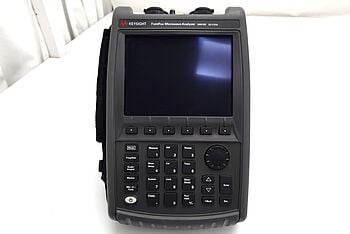
The Allure of Refurbished Handheld Oscilloscopes
When it comes to acquiring handheld oscilloscopes, buying refurbished units presents a compelling option. Here's why:
Affordability Without Compromise
Refurbished oscilloscopes, particularly those from renowned brands like Keysight, offer competitive pricing without sacrificing performance. You get like-new quality equipment while saving up to 70% off the original price.
Eco-Friendly Choice
Choosing a refurbished unit reduces electronic waste and promotes a more sustainable approach to resource utilization. It's a win-win for you and the environment.
Thoroughly Vetted: The Keysight Process
Keysight goes above and beyond to ensure that each refurbished unit meets the highest quality standards. The refurbishment process includes:
- Used unit arrives: The used unit arrives at Keysight’s largest manufacturing site in Penang, Malaysia.
- Condition check: After arrival, the used unit undergoes a thorough initial inspection to assess its condition.
- Comprehensive cleaning: The unit receives in-depth cleaning using specific vacuum-based technology. Any parts that can't be cleaned get replaced.
- Update to latest firmware and software: After verifying its performance, technicians update the unit to the latest compatible firmware and software.
- Customization process: According to customer orders, hardware options, applications, or software options are added or removed.
- Calibration and safety tests: Technicians calibrate the unit and perform safety tests to ensure optimal functionality.
- Original manuals and accessories: The unit receives the same brand-new accessories and manuals as a new Keysight instrument.
- Final 101-point inspection: Before shipment, each instrument undergoes a performance verification and a final 101-point quality check.
- Standard like-new warranty: The factory-refurbished unit receives the same warranty as a new Keysight instrument.
- Unit packed and shipped to customer: Keysight carefully packs the instrument and its accessories before shipping them to the customer.
Each of these steps ensures that you're getting a device that meets Keysight's rigorous quality standards, offering both performance and reliability.
Warranty and Support
Keysight's refurbished units come with the same warranty as new devices, offering you peace of mind that your investment is protected.
Refurbished handheld oscilloscopes offer a smart, sustainable, and cost-effective solution without cutting corners on quality or performance.
Ready to Find Your Perfect Handheld Oscilloscope?
Select up to 3 instruments to compare
Enable Notifications
In order to use this feature, you need to enable notifications.
Manage notification preferences
Making the Right Investment: Think Long-Term
When buying a handheld oscilloscope, short-term considerations like immediate cost and basic functionality should not be the only factors influencing your decision. This is a long-term investment that goes beyond initial purchase price.
A quality handheld oscilloscope serves as a reliable partner for years, offering a perfect blend of functionality, resilience, and unwavering support.
When you invest in a renowned brand like Keysight, you're not just buying a piece of hardware; you're acquiring a meticulously engineered device backed by decades of research and development.
Opt for a model that's robust enough to withstand field challenges, versatile enough to adapt to evolving technological trends, and supported by a company that prioritizes customer satisfaction.
Remember that reputable brands often offer extensive warranty periods and technical support, giving you peace of mind for the years ahead.
In essence, your choice of handheld oscilloscope should align with both your immediate project requirements and your long-term career aspirations.
Look for units that marry quality and innovation, because it's this combination that will empower you to tackle future challenges head-on.
In a world of rapid technological strides, a dependable handheld oscilloscope isn't just a tool—it's your partner in every innovation journey.
Whenever You’re Ready, Here Are 5 Ways We Can Help You
- Browse our premium used network analyzers, oscilloscopes, signal analyzers and waveform generators.
- Call tech support US: +1 800 829-4444
Press #, then 2. Hours: 7am – 5pm MT, Mon– Fri - Talk to our sales support team by clicking the icon (bottom right corner) on every offer page
- Create an account to get price alerts and access to exclusive waitlists.
- Talk to your account manager about your specific needs.

